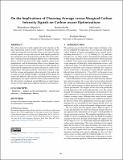On the Implications of Choosing Average versus Marginal Carbon Intensity Signals on Carbon-aware Optimizations
Author(s)
Sukprasert, Thanathorn; Bashir, Noman; Souza, Abel; Irwin, David; Shenoy, Prashant
Download3632775.3661953.pdf (1.062Mb)
Publisher with Creative Commons License
Publisher with Creative Commons License
Creative Commons Attribution
Terms of use
Metadata
Show full item recordAbstract
The carbon intensity of grid-supplied electricity depends on the mix of generation sources used to satisfy its demand and varies widely over time and across locations. There are two types of carbon intensity signals: average and marginal. Both signals provide distinct information about grid operations and affect the electric grid’s short- and long-term functioning in different ways. Unfortunately, there is a lack of consensus on the “right” signal for carbon-aware optimizations, and decarbonization efforts across domains have used both signals to decide when and where to shift demand. To understand the implications of signal selection on carbon-aware optimizations, this paper performs a data-driven analysis using both the average and marginal carbon intensity. Our analysis for 65 regions reveals multiple insights, including i) both signals are statistically different with very low correlation between them, ii) optimizing for one signal could lead to more carbon emissions from the other signal’s standpoint, and iii) differences in signal characteristics in each region lead to different electricity use incentives.
Description
E-Energy ’24, June 04–07, 2024, Singapore, Singapore
Date issued
2024-05-31Publisher
ACM|The 15th ACM International Conference on Future and Sustainable Energy Systems
Citation
Sukprasert, Thanathorn, Bashir, Noman, Souza, Abel, Irwin, David and Shenoy, Prashant. 2024. "On the Implications of Choosing Average versus Marginal Carbon Intensity Signals on Carbon-aware Optimizations."
Version: Final published version
ISBN
979-8-4007-0480-2
Collections
The following license files are associated with this item: